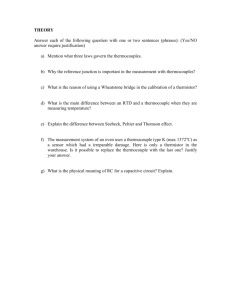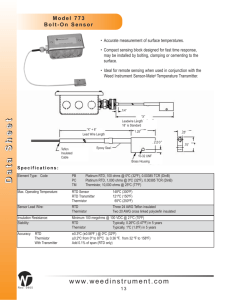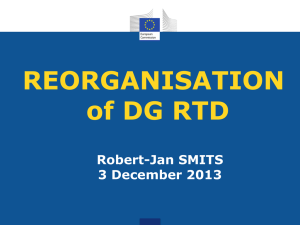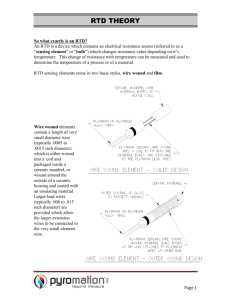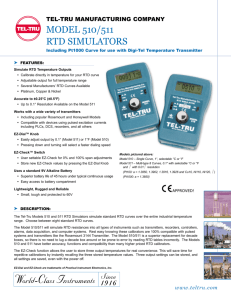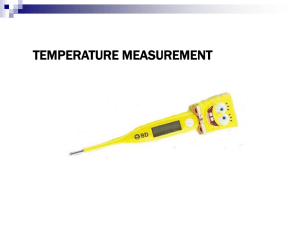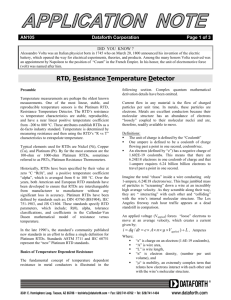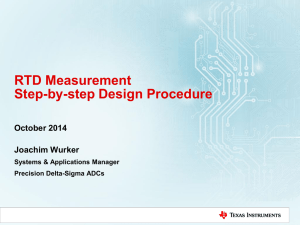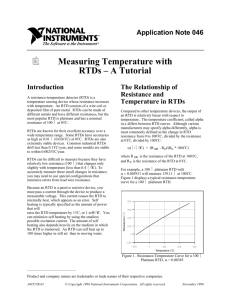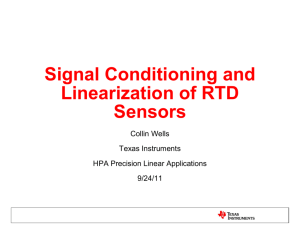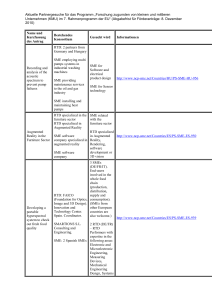Four-Wire RTD measurement
advertisement
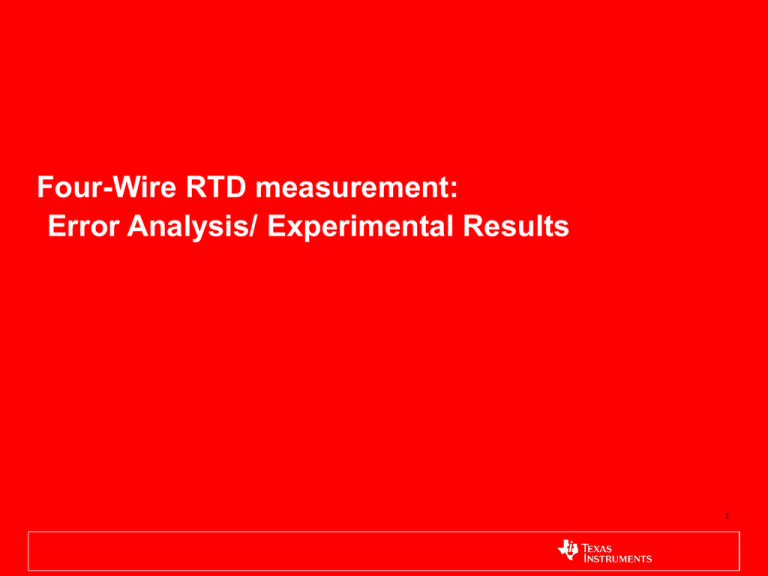
Four-Wire RTD measurement: Error Analysis/ Experimental Results 1 Four-wire RTD Measurement Estimate of Accuracy Ratiometric: IDAC Accuracy/Drift does not add error Accuracy/Resolution of A/D Accuracy of Class A RTD Accuracy of RBIAS Reference Resistor Four-wire RTD Measurement Estimate of typical Accuracy Below is a possible ADS1248 example of a PT-100 4-Wire RTD circuit in a Ratiometric configuration. - Select IDAC current/RBIAS resistor: - Beware of RTD self heating; in this example a large PT-100 probe was used to measure temperature in a thermal oil bath, where the RTD self heating was negligible. Note: In applications where a small RTD is used to measure Air/Gas stream measurements; consider using a lower IDAC current setting to avoid self-heating. - Selected IDAC = 1mA VREF 1mA 2.5kOhm 2.5V VREF 1mA 2.5kOhm 2.5V - Temperature Range: -40C to 140C. RTD @140°C = ~ 157.74Ohms max (Class A) VIN ( Max ) 1mA157.5Ohm ~ 157.5mV - Choose PGA=16 for this example: VIN @140C PGA 16153.7 2.459V VREF 3 Four-wire RTD Measurement Estimate of Typical Accuracy (Using Typical Specifications) • Using the typical Specs in the datasheet, an approximate estimate of the typical expected accuracy can be performed. – The user may calculate the approximate accuracy at each point in temperature using a spreadsheet… • Example using a Class A RTD at 25°C RTD Class A resistance at 25°C = 109.735 Ohm; Class A Tolerance at 25°C is ±(0.15 + 0.002*t)°C= ±0.2 °C • IDAC absolute accuracy and drift does not matter since we are using a ratiometric approach. 4 Four-wire RTD Measurement Estimate of typical Accuracy (Using Typical datasheet specs) • The Reference/Rbias resistor will cause an error proportional to the input voltage: – In this example, a 0.02% high accuracy resistor with 5ppm/C low drift VIN 1mA109.735Ohm 109.735mV RBIAS/REF Error 109.735mV 0.02% 21.937uV • Errors due to Offset, Gain Error and INL of the ADC (Typical Case) Offset ~ 3.75uV GainError 109 .735 mV * 0.005 % 5.487 uV INL _ Error 15 ppmVREF 6 ppm 2.5V 15uV Errordue to ADC (Offset) 2 ( INL) 2 (Gain) 2 (Ref Resistor)2 27.37uV Measuremen t Error in Ohms due to ADC 27.37uV / 1mA 0.0273Ohms Errorin Celsius due to ADC 0.0273Ohms 0.3883Ohms/C 0.071C RTD Class A Tolerance at 25°C is ±(0.15 + 0.002*t)°C= ±0.2 °C T otalErrorin Celsius (Class A RT D Accuracy) 2 (Circuit Error) 2 0.212C 5 ADS1248 Four-wire RTD Measurement Experimental Results RTD: 4-wire Class A RTD Probe Omega PR-10-3-100-3/16-6-E Fluke/Hart Scientific High Precision Thermal Bath 7340 w/ ADS1248EVM-PDK Board Thermal Bath Temperature Sweep from -40°C to +140°C Precision Thermal Bath Temperature Display Resolution is 0.01°C; calibrated to absolute accuracy of 0.02°C. Calibration Baths: Thermal Baths produce use a mixed fluid to provide great thermal contact and stability Used for temperature calibration they provide stability to 0.005C and uniformity 0.006C Display set point Temperature Resolution 0.01C Thermal Bath Fluid:Propene (Galden HT200) 6 ADS1248 Four-wire RTD Measurement Experimental Results Important Note: The actual performance in a given system may be different and depends on many variables, including (but not limited to) the application schematics, PCB layout, temperature-forcing system accuracies, and environmental noise contributions, among other factors. TI offers no assurance of system performance other than the performance parameters detailed in the Electrical Characteristics section of the ADS1248 product data sheet . 0.5 Class A RTD tolerance 0.4 Temperature Error (C) 0.3 Experimental Results 0.2 0.1 0.0 -0.1 -0.2 -0.3 Class A RTD tolerance -0.4 -0.5 -40 -20 0 20 40 60 80 Thermal Bath Temperature (C) 100 120 140 Calculated Accuracy 7
